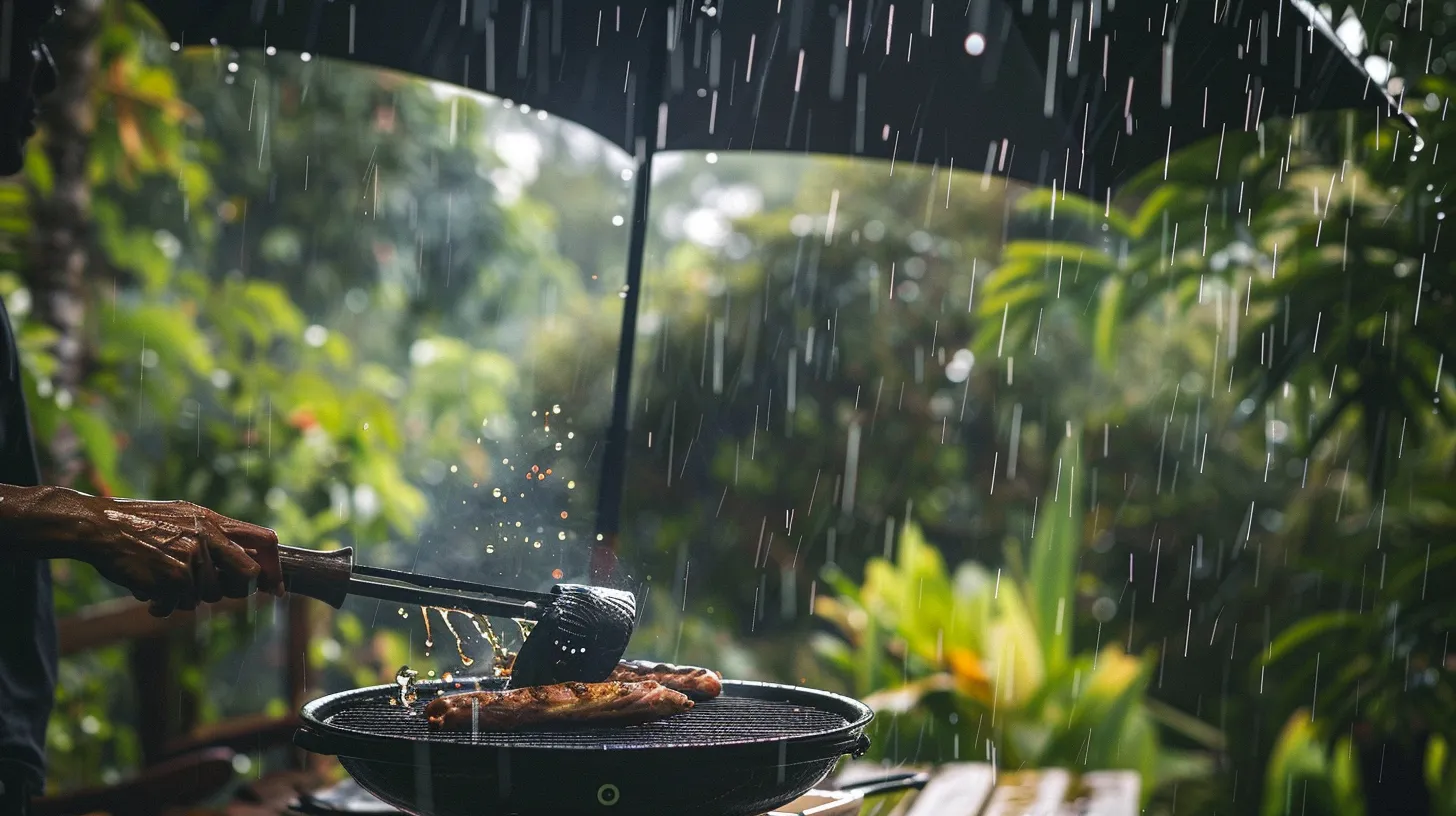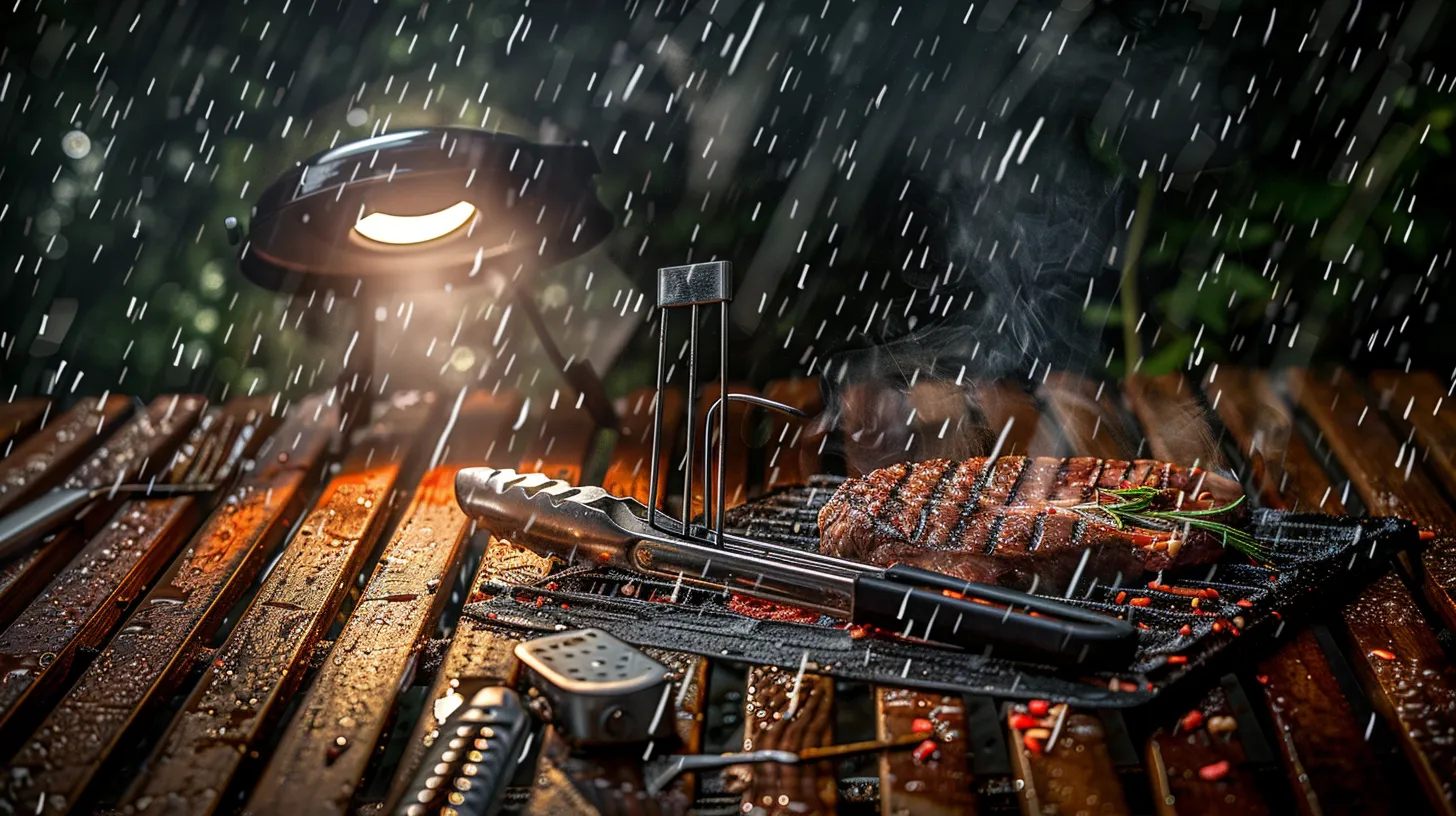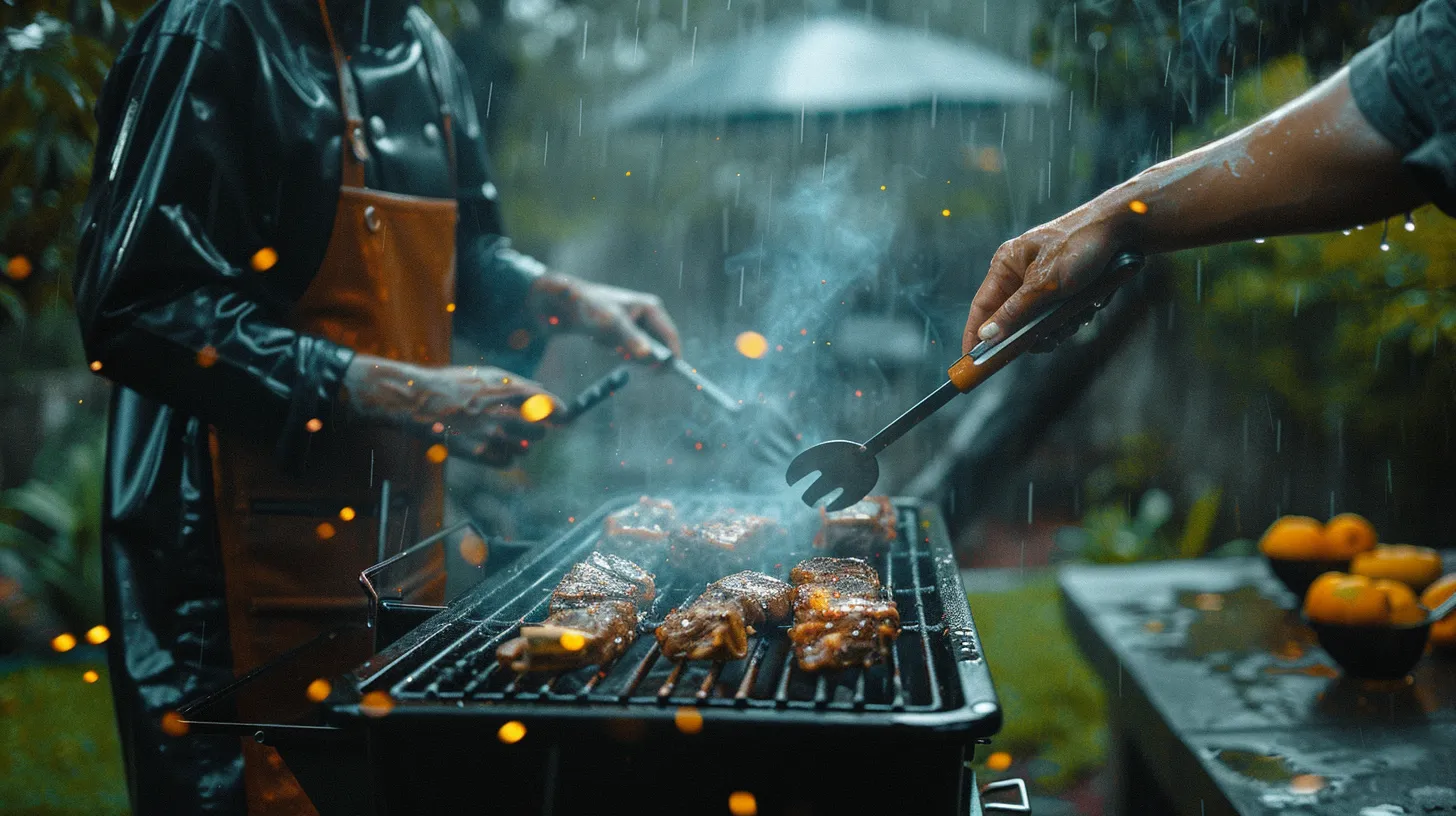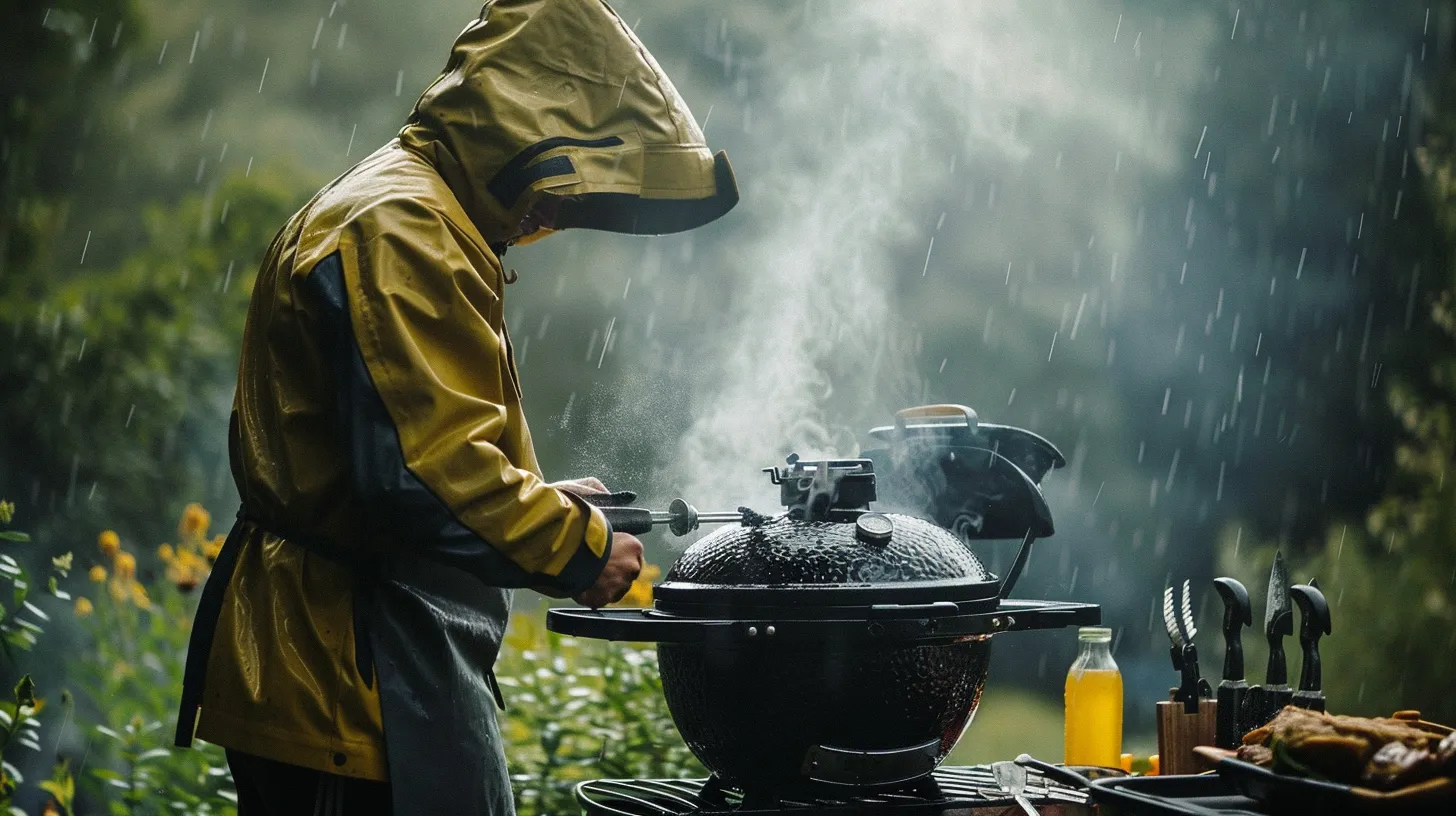Grilling in the rain requires careful planning and the right equipment. Opt for gas, charcoal, or pellet grills , as they are safest under wet conditions. Always use a grill with a secure lid to help maintain temperature and protect the flames. Set up the grill under a canopy or umbrella to keep the area dry. Utilize indirect grilling methods for even cooking and enhanced flavor. Additionally, maintain a consistent grill temperature, shielded from wind and rain with windbreaks . Employ these strategies to turn challenging weather into an opportunity for a delightful grilling experience. Further insights await that will elevate your rainy-day grilling sessions.
Grilling Safety Precautions

When grilling in rainy conditions, prioritizing safety is vital, particularly making sure that electric grills are avoided due to the heightened risk of electrocution. Opting for gas, charcoal, or pellet grills which are safer in wet weather is advisable. Additionally, it is important to keep the grill covered with a lid. This practice not only secures the grill from rainwater but also retains the necessary heat for cooking. Without a lid, the heat will escape, making it challenging to maintain consistent cooking temperatures and potentially prolonging cooking times.
Using a grill in the rain requires careful attention to maintaining a stable and safe environment. Ensure that the grill is placed on a flat, stable surface to prevent any accidental tipping over, which can be more likely on wet, slippery surfaces. Keeping all pathways clear of obstructions and ensuring the grilling area is well-lit and free of standing water are also important safety measures. Remember, grilling under covered areas such as pergolas can provide additional protection from the elements, but always confirm that the structure provides sufficient ventilation to safely disperse smoke and prevent any buildup of harmful gases.
Choosing the Right Equipment

After discussing safety precautions, it is equally important to focus on selecting the right equipment for grilling in the rain. Gas, charcoal, and pellet grills are robust choices as they are designed to operate safely under wet conditions. Specifically, a charcoal grill can be an excellent option for those who prefer the smoky flavor it imparts to food. However, it's vital to make sure that any grill chosen has a well-fitting lid , which helps manage the temperature and protect the flames from raindrops.
In addition to selecting a suitable grill, consider enhancing your setup with a patio umbrella or other forms of overhead cover like canopies or awnings. These not only shield you from the rain but also help keep the grill operating efficiently by preventing excessive water from dousing the coals or affecting the burners. This setup ensures that your grilling experience remains comfortable and uninterrupted, rain or shine.
The Indirect Grilling Method

Mastering the indirect grilling method allows for cooking larger cuts of meat evenly, by strategically placing them next to the heat source rather than directly over it. This technique is especially valuable when grilling in the rain, as it minimizes the chances of flare-ups from water hitting the coals or burners. The indirect grilling method utilizes a two-zone fire setup , which is essential for managing cooking temperatures under less predictable weather conditions.
By setting up your grill with a hot side and a cooler side, you provide a safe zone where food can cook gently, reducing the risk of burning. This method is not only ideal for meats but also for smoking meats and roasting vegetables , enhancing their flavors without charring. The slow cooking process inherent in indirect grilling ensures that foods remain juicy and tender, infused with a smoky aroma that direct heat cannot achieve.
For those looking to perfect their grilling skills, here are some tips and tricks: always preheat the grill to establish a stable temperature before adding your food. Keep the lid closed as much as possible to maintain consistent heat , especially important when conditions are windy or wet. This technique transforms a basic barbecue into an all-weather cooking adventure.
Shelter and Placement Strategies

To effectively grill in rainy conditions, selecting the right type of shelter and strategically placing your grill are essential steps. Shelter and placement strategies are vital for successful grilling in rainy weather. A well-anchored patio umbrella offers a basic solution for light rain, allowing some flexibility with placement. However, for more persistent or heavy rainfall, a BBQ canopy can be invaluable. These canopies are designed to cover a small area, sufficient for the grill and the griller, thereby keeping both dry during the cooking process.
For those with a deck or patio, installing a retractable awning can create a versatile covered grilling area that is usable in various weather conditions. This option provides the advantage of being a semi-permanent solution without the necessity for year-round commitment. On the other hand, a permanent covered grilling station might be the best choice for avid grillers. This setup ensures that regardless of the weather, the grilling can continue uninterrupted .
Alternatively, setting up a tarp tent or a dining fly tent can offer a temporary yet effective shelter . This method is particularly cost-effective , providing substantial protection from rain, thereby ensuring that neither the spirit of grilling nor the grill itself is dampened by the weather.
Monitoring and Adjusting Temperatures

Effective temperature management is vital for grilling successfully in rainy conditions, requiring adjustments to both charcoal and gas grills to maintain consistent heat. Monitoring temperatures is essential, and the use of a remote thermometer can provide precise control over the cooking environment. This tool allows the chef to stay updated on the internal grill temperature without having to frequently open the lid, which can lead to significant heat loss, especially in windy and wet conditions.
Adjusting temperatures on a charcoal grill involves managing the vents effectively . Opening or closing the vents will help stabilize the grill's internal temperature by either increasing oxygen flow to boost the fire or restricting it to lower the heat. It is important to carefully balance these adjustments to maintain a steady cooking temperature, despite the intermittent gusts and rain.
For gas grills, make sure that the burners are protected from rain to prevent them from blowing out. This can be achieved by strategically placing a wind block , which not only shields the flame but also helps in maintaining a consistent temperature. Regular checks and minor adjustments to the flame and burner settings might be necessary to counteract the cooling effects of the rain.
Handling Wind and Weather Challenges
Grilling in windy conditions demands strategic modifications and diligent monitoring to guarantee stable cooking temperatures. On a rainy day, the challenges amplify, requiring grillers to be adept at managing both moisture and wind. One effective strategy is to construct a windbreak around the grilling area. Stable materials such as plywood can shield your grill from gusts, thereby reducing the impact of wind on temperature control. This setup helps in maintaining a consistent cooking environment despite adverse weather conditions.
Additionally, it's essential to monitor and adjust the fuel source in charcoal grills . Wind and moisture can cause charcoal to absorb humidity, leading to fluctuating temperatures. Regular checks will ensure that the charcoal remains effective for cooking. A remote grill thermometer is invaluable under these conditions, offering the ability to closely track the grill's internal temperature without having to expose oneself to the elements repeatedly.
Further, adjusting the grill vents can play a pivotal role in managing airflow and maintaining the desired temperature. Proper vent management helps counteract the effects of wind, ensuring that airflow is controlled and consistent, which is vital for achieving reliable grilling results despite the challenging weather.
Essential Grilling Accessories
Choosing the right accessories can greatly enhance the grilling experience, especially under challenging weather conditions. For those who frequently battle inclement weather, investing in quality protective gear for your grill is indispensable. One essential item is a grill cover , which safeguards your grill from moisture and prevents rust—critical for maintaining the longevity of charcoal grills. In addition to a cover, consider a grill canopy or a grill gazebo . These structures not only shield the grill but also the grilling area, ensuring that rain or shine, your barbecue can go on without a hitch.
For grill enthusiasts working with limited space , a grill umbrella emerges as a practical solution. Unlike more extensive setups, these umbrellas are budget-friendly and occupy minimal space, yet they offer sufficient protection during light rainfalls, making them ideal for smaller patios or balconies.
Moreover, joining online communities like the Kick Ash Crew on Facebook can be beneficial. This forum allows you to connect with fellow barbecue lovers, exchange tips, and discover new grilling accessories tailored to wet weather conditions , ensuring your grilling skills remain sharp no matter the weather.
Cooking Techniques in Wet Conditions
Adapting your cooking techniques to accommodate wet weather conditions can greatly enhance your grilling experience and outcome. In heavy rain, the reverse searing method is particularly effective for cooking burgers and steaks. This technique involves initially cooking the meat at a lower temperature inside the grill , then searing it over high heat to finish . This guarantees even cooking and best flavor, despite the challenges posed by moisture.
For longer cooking times, opt for slow-cooking meats such as brisket or pork butt. These cuts benefit from the longer, slower cook process, which helps retain moisture and tenderness , making them ideal for rainy conditions. Additionally, wrapping vegetables in foil before placing them on the grill can prevent them from becoming waterlogged while enhancing their flavors.
To further adapt to wet weather grilling, consider pre-cooking meats indoors . This strategy allows you to minimize the time your food needs to be exposed to the elements. By partially cooking meats like chicken or ribs inside your kitchen, you reduce their grill time outside, ensuring they are thoroughly cooked while still receiving that desirable smoky flavor from the grill.
Maintaining Grill Performance
While adjusting your cooking techniques for wet weather is beneficial, maintaining peak grill performance is equally important to guarantee successful outcomes. One critical aspect in rainy conditions is managing the grill's temperature . Increased fuel may be necessary to compensate for the cooling effects of rain and to prevent fluctuations that can affect cooking consistency. Keeping the lid closed as much as possible also aids in maintaining a stable cooking environment, reducing the risk of heat loss.
Furthermore, it's crucial to block wind, which can be unpredictable during storms and can further disrupt the temperature balance within your grill. Setting up a windbreak can shield your grill from gusts that might extinguish flames or cool down the grill surface unevenly.
Patience is key when grilling in wet weather. Allow more time than usual for your grill to preheat and for food to cook through. Opting for meats that require shorter cooking times can also streamline the process. Most importantly, the use of a wireless meat thermometer cannot be overstated. This tool allows for precise monitoring of food temperature without frequently opening the grill lid, minimizing heat escape and ensuring successful cooking results while maintaining safety by avoiding exposure to carbon monoxide .
Post-Grilling Care and Storage
Proper post-grilling care and storage are essential to extend the lifespan and maintain the efficiency of your grill. After each use, a thorough cleaning is important to prevent rust and corrosion , particularly on cold days when moisture can be more damaging. Making sure that all food particles and grease are removed will safeguard the grill's components.
It is equally important to store your grill in a dry area , shielded from the elements. Exposure to rain can lead to deterioration, so choosing a location under a shelter or inside a garage can provide excellent protection. Additionally, investing in a high-quality grill cover is an effective way to protect your grill when it is not in use. Such covers are designed to repel water and shield the grill from debris and dust.
Moreover, regular maintenance of the grease trap is necessary. Emptying and cleaning it regularly prevents buildup that could pose fire hazards . Finally, inspect your grill periodically for any worn-out parts or components. Replacing these parts promptly ensures that your grill remains in good working condition, ready for your next rainy day barbecue adventure, and prolongs its overall functionality and appearance.










